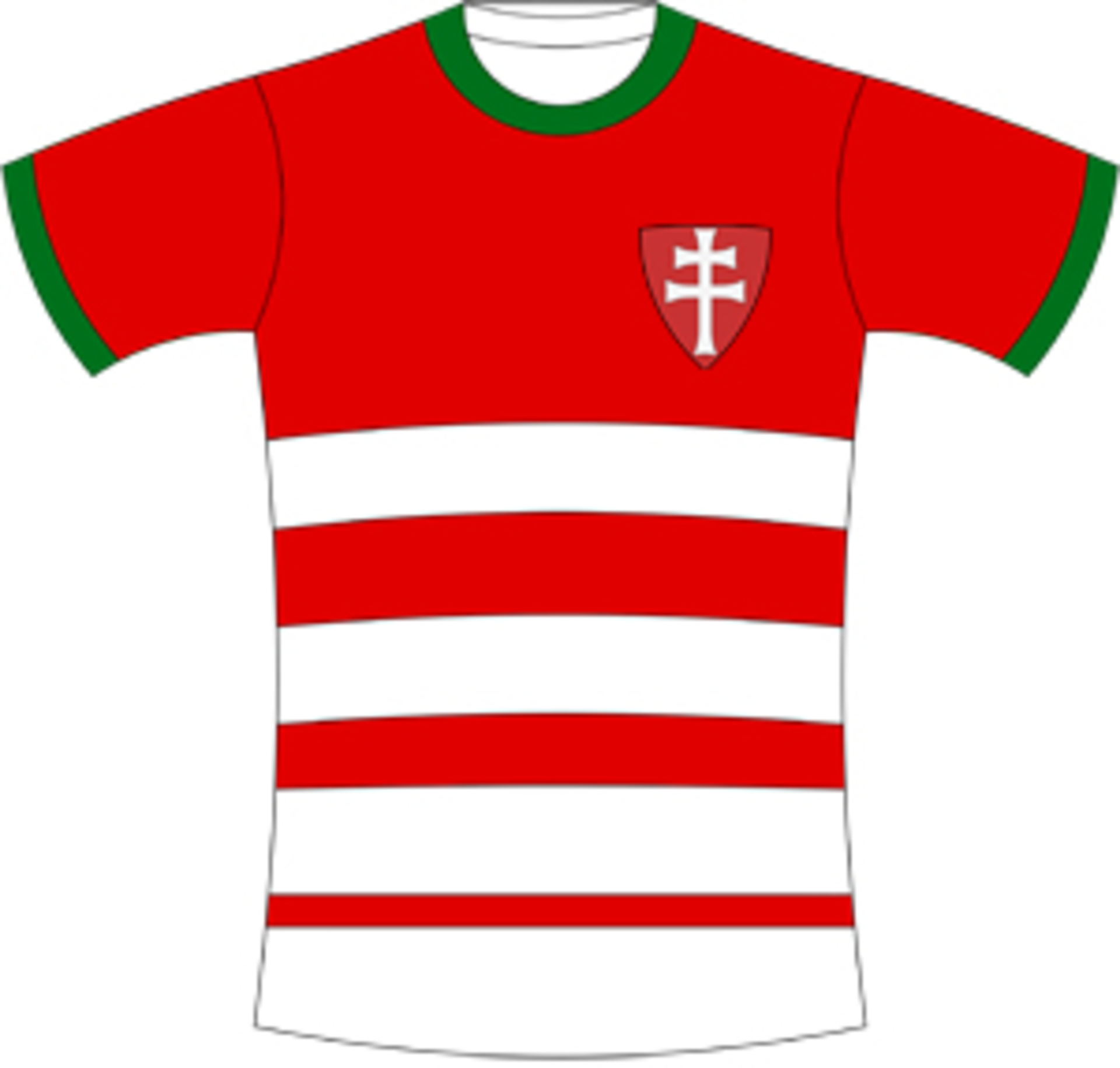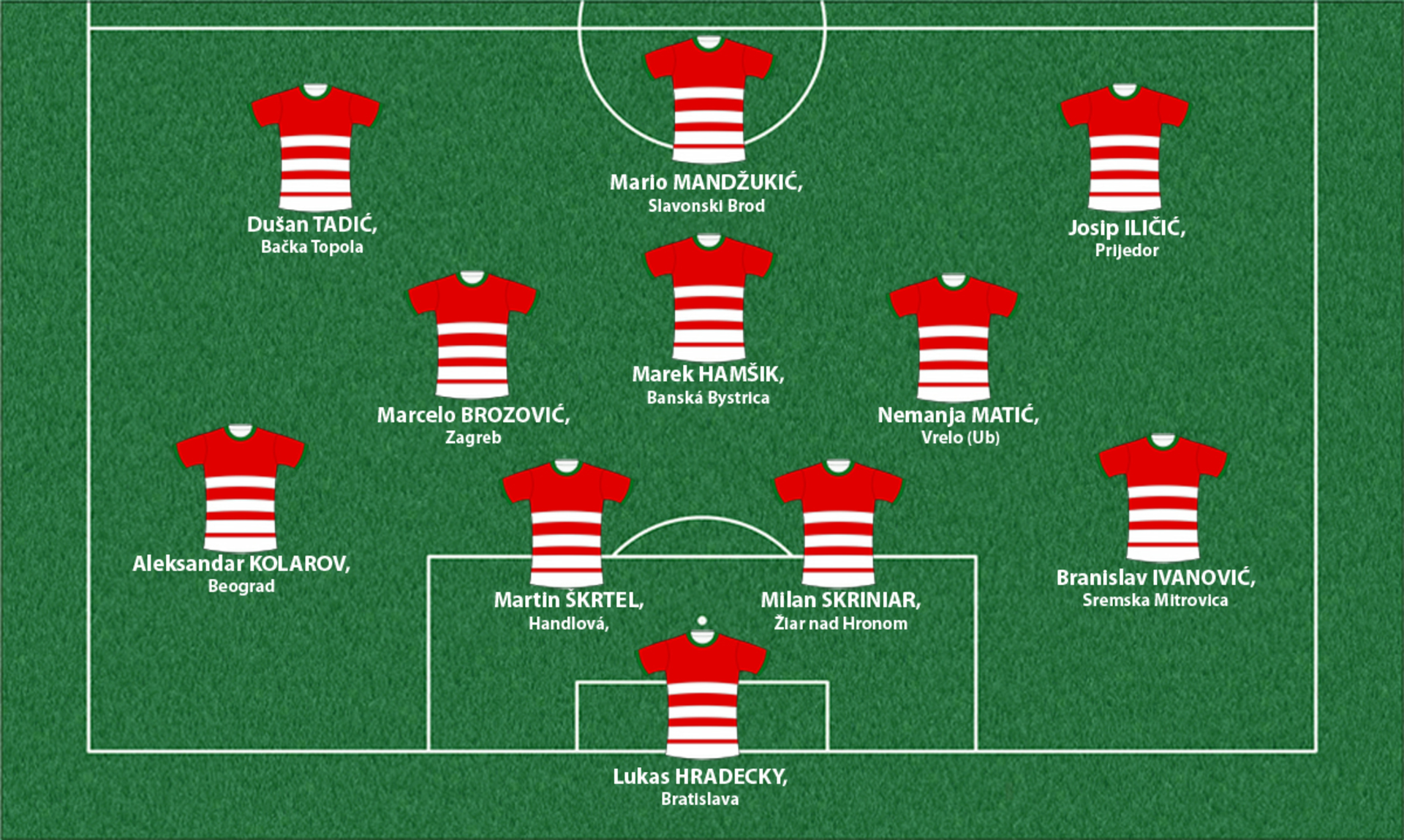The Lands of the Hungarian Crown
The Lands oft he Hungarian Crown or the Arch-Kingdom of Hungary (lat. Archiregnum Hungaricum) was a dynastic state constitued of several political units with different status (''the land'' or regna) with Kingdom of Hungary as the 'core' in the Panonian Plain. Although the borders often changed, during the most oft he period from the 12th to the 16th century, it stretched from the Carpathians to the north and east, beyond the right coasts of Sava and the Danub, all the way to the Adriatic coast in the south. Of course, not all inhabitans were "Hungarians". State was marked by religious and ethnic diversity. Modern Croatian historiography uses the name of the Croatian-Hungarian kingdom, which, as such, has never been recorded in medieval sources.

Coat of arms

Shirt
| Position | First name | Last name | Mjesto rođenja | Like | Dislike | |
|---|---|---|---|---|---|---|
| GK | Josip | POSAVEC | Varaždin |
20 |
6 |
|
| GK | Lukas | HRADECKY | Bratislava |
15 |
6 |
|
| GK | Peter | GULASCI | Budapest |
8 |
2 |
|
| DC | Martin | ŠKRTEL | Handlová |
32 |
10 |
|
| DC | Matej | MITROVIĆ | Požega |
9 |
3 |
|
| DC | Milan | ŠKRINIAR | Žiar nad Hronom |
41 |
6 |
|
| DC | Vedran | ĆORLUKA | Derventa |
40 |
5 |
|
| DRC | Branislav | IVANOVIĆ | Sremska Mitrovica |
43 |
15 |
|
| DRC | Tin | JEDVAJ | Zagreb |
29 |
7 |
|
| DLC | Tamas | KADAR | Veszprem |
10 |
5 |
|
| DRLC | Domagoj | VIDA | Našice |
34 |
6 |
|
| DR | Romario | BENZAR | Timișoara |
5 |
5 |
|
| DL/ML | Aleksandar | KOLAROV | Belgrade |
45 |
13 |
|
| DMC | Ljubomir | FEJSA | Kula |
9 |
11 |
|
| DMC | Milan | BADELJ | Zagreb |
45 |
6 |
|
| DMC | Nemanja | MATIĆ | Vrelo |
60 |
10 |
|
| MC | Stanislav | LOBOTKA | Trenčín |
10 |
6 |
|
| MC | Zlatko | JUNUZOVIĆ | Loznica |
11 |
9 |
|
| MRLC | Marcelo | BROZOVIĆ | Zagreb |
45 |
5 |
|
| AMC/SS | Josip | ILIČIĆ | Prijedor |
11 |
6 |
|
| AMC/SS | Marek | HAMŠIK | Banská Bystrica |
39 |
5 |
|
| AMRLC | Dušan | TADIĆ | Bačka Topola |
21 |
9 |
|
| AMRLC | Marko | ROG | Varaždin |
18 |
2 |
|
| AMRLC | Nicolae | STANCIU | Alba Iulia |
10 |
11 |
|
| AMRL | Balazs | DZSUDZSAK | Debrecen |
8 |
5 |
|
| AMRL | Mijat | GAĆINOVIĆ | Novi Sad |
9 |
10 |
|
| AMRL | Zoran | TOŠIĆ | Zrenjanin |
5 |
6 |
|
| FRLC | Claudiu | KESERU | Oradea |
4 |
5 |
|
| FRLC | Duje | ČOP | Vinkovci |
12 |
4 |
|
| FRLC | Mario | MANDŽUKIĆ | Slavonski Brod |
50 |
1 |
|
| FRLC | Marko | PJACA | Zagreb |
18 |
0 |
|
| FRLC | Uroš | ĐURĐEVIĆ | Belgrade |
8 |
8 |
|
| FC/SS | Andrej | KRAMARIĆ | Zagreb |
44 |
3 |
(Today part of: Hungary, Slovakia, parts of Croatia, northern Serbia, northern BiH, western Romania)
The rise of Hungary began with the ruler Vaik form the Árpád dynasty who, after becoming a king around the year 1000 and being Christened, took on the name Stephen I (ruled 997-1038), and who, by virtue of being the organizer of the hierarchy of the Church in Hungary that came after a bloody conflict with the pagan populace, was given the title of “Saint.” As was the case with Poland, the foundation of the Church bound directly to Rome influenced its gaining independence from the Emperor. Hungarian kings spread their rule eastward where they conquered Transylvania or Erdély, which will have a large autonomy as a border area often exposed to the attacks from external enemies (Kumani). In the south, the state expanded to the Adriatic, where at the beginning of the 12th century the Hungarian ruler was crowned for the king of Dalmatia and Croatia.
There is no reliable evidence that the Hungarian king merged or joined (in the sense of a personal union) Dalmatia and Croatia in his state, but it is clear that the vast distance of the royal seat in the Pannonian Plain (Esztergon, Székesfehérvár, Visegrád, Buda) left Croatian nobility enough space for independent activity in the territory of Croatia, located in the Dinaric hinterland of the eastern Adriatic coast. As far as the "Byzantine" Dalmatia is concerned, until the beginning of the 15th century and the strengthening of Venetian rule, it did not exist as a unique entity. Closed in their communes, its cities independently decidedtheir own destinies. For example, in the mid-13th century,Trogir, unlike Split, was loyal to King Bela IV. (1235-70), while Zadar was in the hands of Venice. Also during the 13th century in the area between rivers of Sava and Drava, or more precisely the Bishopric of Zagreb, Slavonia began to take shape and, like Transylvania, had a relative autonomy within the Arch-Kingdom.
The first half of the 13th century on the socio-political plan was marked by: issuing the so-called "Golden Bull’’ with which the rights of the king and noblemen were divided in favor of the latter, which led to the development of cities as a result of bestowing the status of Free Royal Cities, and the settling German population there (especially in Transylvania). Furthermore, in the mid-13th century the Mongols invasion devastated the Kingdom, same as the rest of Eastern and Central Europe. As a result of that, “Banats”- military-administrative units -were established in the border areas along the Sava and the Danube, and strong fortresses throughout the Kingdom were built to prevent future similar attacks. Also, the Hungarian kings weresummoned by the pope to crusade against the local heretic movement in Bosnia, which was used as an excuse for the political subordination of the local government and its territory.
The noble elite made up of some fifty families, most of which were Hungarian, played an important role in running the country. After the last member of the royal family of Árpád had died (1301.), the Kingdom of Hungary became a scene of conflict for the throne, and the branch of the Anjou family (r. 1301-1386), which ruled the Kingdom of Naples, came out of it as victors.
Sources
- Stanko ANDRIĆ, ''Slavonija'', http://hipsb.hr/slavonija/
- Mladen Ančić, ''Od zemlje do kraljevstva- mjesto Bosne u strukturi Archiregnuma'', Hercegovina: Časopis za kulturno i povijesno nasljeđe, vol.26, br.1, listopad, 2015.
- Tomislav BALI, Slavonski meandar - Prostor i pojam Slavonije u XIII. Stoljeću, Zagreb: Srednja Europa, 2014.
- Marc BLOCH, Feudalno društvo, Zagreb, 2001.
- Ulf DIRLMEIER, Povijest Njemačke, Zagreb, 1999.
- Vinko FORETIĆ, Studije i rasprave iz hrvatske povijesti, Split, 2001.
- Ladislav HEKA, ''Hrvatsko-ugarski odnosi od srednjeg vijeka do Nagodbe iz 1868. s posebnim osvrtom na pitanje Slavonije'', ScriniaSlavonica, 8/2008, br.1.
- Bože MIMICA, Slavonija od antike do XX. stoljeća, Zagreb, 2009.
- Geza PALFFY, '' Prekogranična povezanost Nikole IV. i Nikole VII. Zrinskog '', Susreti dviju kultura: obitelj Zrinski u hrvatskoj i mađarskoj povijesti (gl.ur. Romana Horvat),Zagreb, 2012.
- ''banovina'', http://www.enciklopedija.hr/Natuknica.aspx?ID=5742
- ''Duke of Transylvania'', https://en.wikipedia.org/wiki/Duke_of_Transylvania
- ''Kingdom of Hungary'', https://en.wikipedia.org/wiki/Kingdom_of_Hungary#High_Middle_Ages
- '' Mađarska'', http://www.enciklopedija.hr//natuknica.aspx?ID=37947
- ''slobodni kraljevski gradovi'', http://www.enciklopedija.hr/Natuknica.aspx?ID=56666
- ''Zlatna bula Andrije II.'', http://www.enciklopedija.hr/Natuknica.aspx?ID=67294
- Zlatko Lukić, Ban Matija Ninoslav'' http://povijest.net/matija-ninoslav/
- Grb: https://en.wikipedia.org/wiki/Coat_of_arms_of_Hungary
